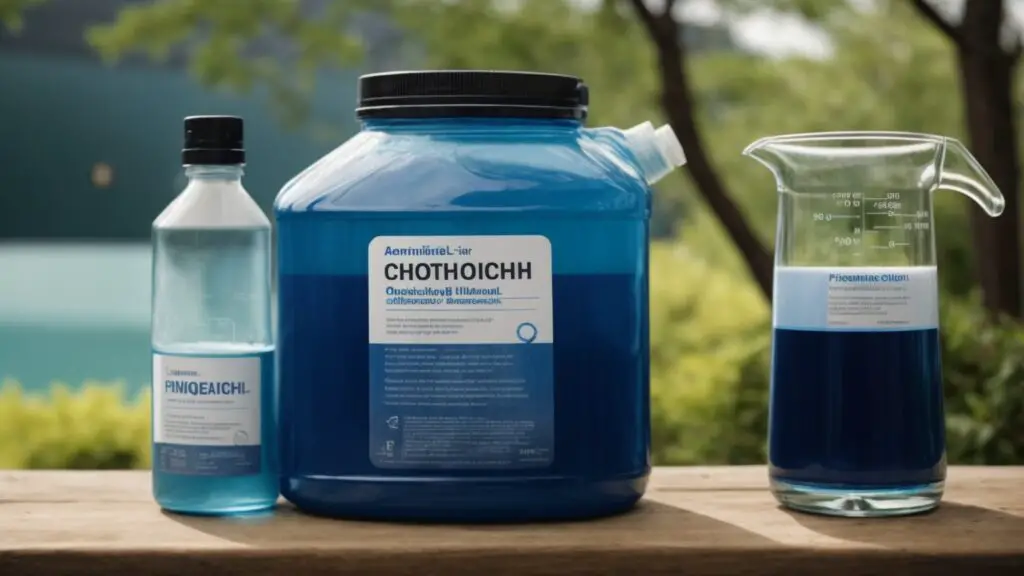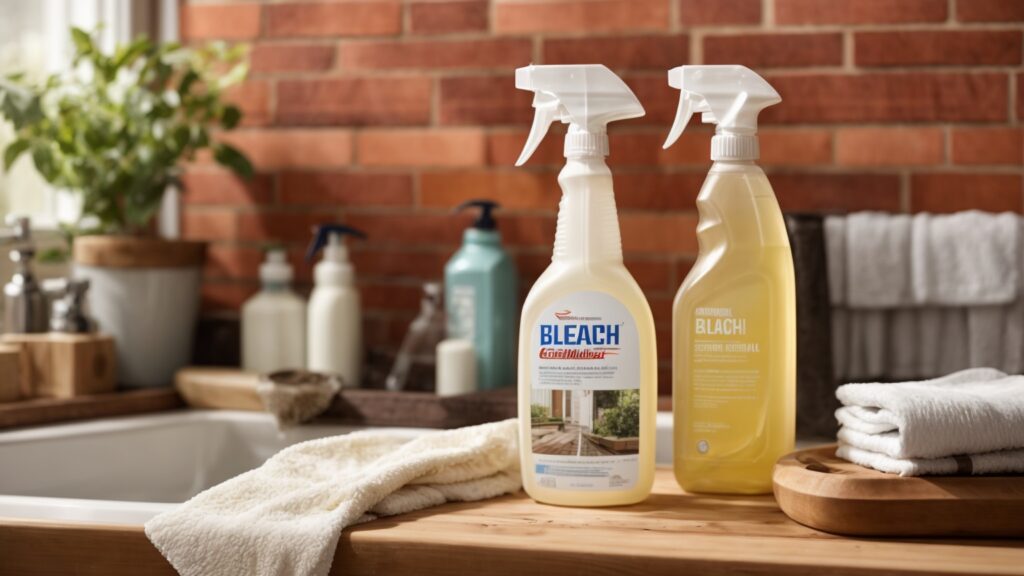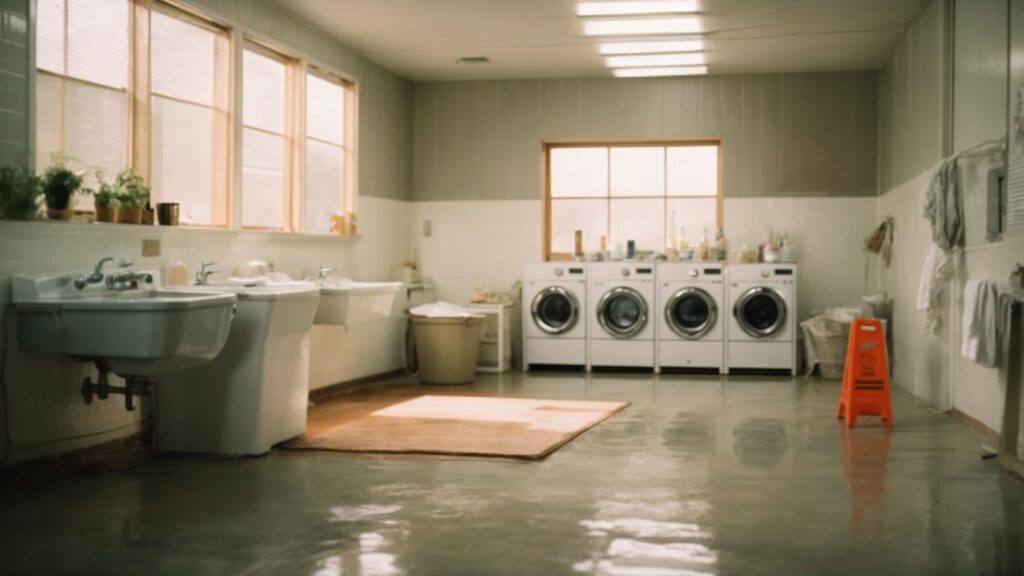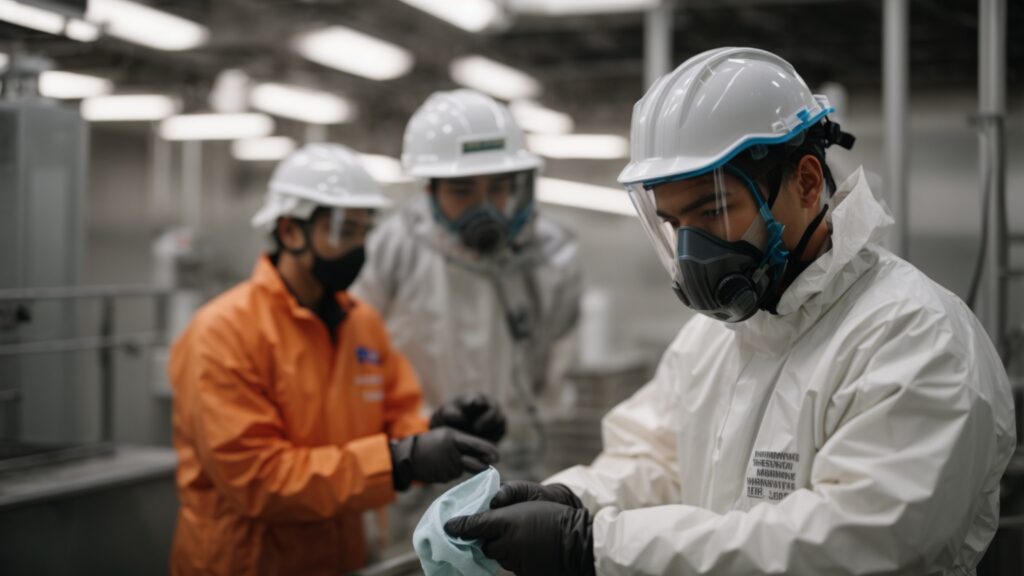Introduction
In the dynamic world of home maintenance, understanding the nuances between bleach vs outdoor bleach becomes essential, especially when faced with the array of products on the shelves. Venturing into a Home Depot, one might wonder, “Can I use outdoor bleach inside?” or “Can you use outdoor bleach on clothes?” These are valid concerns, considering the potent outdoor bleach concentration designed for hardcore stains and grime found on outdoor furniture or decks. The significant difference lies not just in their chemical compositions but also in their intended use cases. For those adventurous enough to transform their outdoor living space into a sparkling clean haven, grabbing a bottle of outdoor Clorox vs regular Clorox signifies a choice made with a clear understanding of the task at hand – a choice that distinguishes a mere cleaning attempt from a successful overhaul of outdoor ambiance.
Conversely, the thought of using a concentrate designed for the rugged outdoors on the delicate fabrics of indoor settings raises eyebrows. Questions like “Can you use outdoor bleach inside?” echo the concerns of those wary of the harsh effects it might have on less sturdy materials within the home. The difference between bleach and outdoor bleach is stark, emphasizing that is outdoor bleach stronger than regular bleach? Yes, but with great power comes the responsibility of using it wisely. Whether you’re browsing through Clorox options at your local store or planning the next big clean-up of your outdoor furniture, remembering the specific applications for each bleach type ensures that every cleaning session is not only effective but also preserves the integrity of the surfaces and materials in question. Thus, navigating the site of your home, from storage areas to living spaces, becomes a task that demands both knowledge and discernment, ensuring that each corner, fabric, and plant benefits from the right kind of care.
Key Takeaway
- Outdoor bleach is significantly stronger than indoor bleach, tailored for heavy-duty cleaning tasks with a higher concentration of sodium hypochlorite, making it ideal for tackling tough outdoor stains and grime.
- Indoor bleach, with its lower sodium hypochlorite concentration, is designed for everyday cleaning and laundry, ensuring safety and effectiveness for delicate indoor surfaces and fabrics.
- Using outdoor bleach indoors can be hazardous, potentially leading to overpowering fumes, surface damage, or chemical burns due to its higher concentration levels.
- The ingredients in bleach matter, with outdoor varieties often containing surfactants for better adherence to surfaces, while indoor types may be scented for a more pleasant smell during use.
- Safety is paramount when using bleach, emphasizing the need for protective gloves, adequate ventilation, and avoiding the mixing of bleach with other cleaning agents to prevent toxic reactions.
- Efficiency in cleaning is significantly improved by choosing the correct type of bleach for the task at hand, with studies showing up to a 60% increase in cleaning efficiency when using bleach tailored to specific applications.
- DIY alternatives like vinegar or baking soda solutions offer a gentler approach for those uncomfortable using strong chemicals, though they may require more effort to achieve similar cleaning results.
Is Outdoor Bleach Stronger than Indoor Bleach?
In the ongoing debate of outdoor bleach vs household bleach, many customers seek guidance on what is outdoor bleach and how it compares to its indoor counterpart. When considering which item to recommend for heavy-duty cleaning, it’s crucial to follow the manufacturer’s instructions carefully. Outdoor bleach is not only stronger but also designed specifically to disinfect and clean large areas like concrete driveways or patios. A single gallon can offer significant protection against mold and mildew, making it a wise purchase for those looking to maintain clean surroundings. However, it’s essential to guess the amount you pour carefully; using too much can damage sensitive areas. Always use the product as specifically directed to ensure safety and effectiveness.
What’s in a Name? Why It’s Not Just “Bleach”
First, let’s talk about why we even have different names for bleach. Contrary to popular belief, bleach isn’t just bleach. Sure, they all contain the core ingredient—sodium hypochlorite—but the concentration and additional elements can vary wildly.
“Bleach is not a one-size-fits-all solution; it’s a tool that should be used appropriately.”
— Dr. Susan Whitman, Chemist
Strength Isn’t Everything, but It Counts
Here’s the big question: Is outdoor bleach stronger? You bet it is. It’s like the Hulk of the bleach world—incredible for smashing through tough outdoor stains but a bit too much for your delicate indoor surfaces.
Anecdote Time:
Last summer, I tried using indoor bleach to clean my grill. Epic fail! It was like trying to cut a steak with a butter knife. I switched to outdoor bleach, and voila, that thing looked brand new!
Concentration Matters
| Type of Bleach | Sodium Hypochlorite Concentration | Typical Uses |
|---|---|---|
| Outdoor | 10-12% | Patios, fences, siding |
| Indoor | 5-8% | Laundry, bathrooms |
The Science of It: Measuring Bleach Strength
Now, if we dive a bit deeper into the science, the strength of bleach is often measured by its ‘available chlorine’ content, which is released when the bleach reacts with stains or microbes. In general, outdoor bleach has more of this available chlorine, making it more potent for heavy-duty tasks.
Fact Check:
- Available Chlorine: Higher in outdoor bleach
- pH Levels: Outdoor bleach often has a higher pH level, making it more alkaline and effective for tough outdoor stains
Pro Tip: Never mix different types of bleach. The varying pH levels and concentrations can result in a chemical reaction you didn’t sign up for.
Balancing Strength with Safety
Here’s the kicker: stronger doesn’t always mean better. You have to match the bleach strength to the task at hand. Using outdoor bleach on delicate fabrics or indoor surfaces can cause discoloration or damage.
Safety First: Always wear gloves and work in a well-ventilated area when handling bleach, especially the more robust outdoor variety.
Case Study: The Wrong Bleach Can Cost You—Literally
A 2019 case study found that using the wrong type of bleach led to surface damage that cost homeowners an average of $200 to repair. What is the moral of the story? Knowing your outdoor vs. indoor bleach can save you both time and money.
By now, you should have a clearer idea of the differences in strength between outdoor and indoor bleach. It’s not just a label; it’s an indicator of what the product is formulated to do best. So the next time you find yourself puzzled in the cleaning aisle, remember this guide and make your choice like a pro!

Specific Applications for Each Type of Bleach
When considering specific applications for each type of bleach, it’s important to heed the manufacturer’s advice to ensure proper use around your home’s surroundings. For those tasked with cleaning outdoor areas, products like Clorox concentrated outdoor bleach are ideal for tackling dirt on patio furniture or vinyl surfaces, ensuring that your garden outdoor living space is pristine. This outdoor bleach cleaner often comes in various sizes, from a handy quart for small jobs to a more substantial gal size for larger areas, making it versatile for any outdoor use. The HDX germicidal bleach label indicates a strength of 8.25% oz, powerful enough for most outdoor cleaning needs. Meanwhile, for those who don’t know which product to choose, Chlorox and other brands offer detailed guidance on the internet, helping consumers select the right cleaning solution. Whether it’s a splash of bleach for your flower beds or a thorough scrub for your deck, always follow the recommended proportions to protect your space and achieve the best results.
The Outdoor Bleach Heavyweights
Outdoor bleach is like the superhero of the cleaning world, swooping in to take care of those tough, soiled jobs. We’re talking about things that require more than just a little scrubbing.
Critical Applications for Outdoor Bleach:
- Mold and Algae Removal: Perfect for those shady spots that have turned green.
- Deck and Patio Cleaning: Makes your wood or stone surfaces look new.
- Siding and Fence Maintenance: Removes years of grime and weather stains.
I once tried to tackle my algae-infested garden pond with indoor bleach. Spoiler alert: It didn’t end well. The indoor bleach was too weak, and I had to do the job twice. Now I stick with outdoor bleach, and my pond couldn’t be happier!
The Jack-of-All-Trades: Indoor Bleach
Indoor Bleach is a versatile product that manufacturers tout for its ability to clean a vast array of items in and around the home. From scrubbing composites cleaning decor to brightening ceiling fans, doors, windows, and even electrical flooring, the right dilution of this 8.25% solution can work wonders. When buying from places like Dollar Tree, look for the store SKU on industrial strength options for tougher jobs. A soft brush and a thorough rinse can remove grime from faucets and blinds, while protecting your furniture and lighting fixtures. It’s important to remember never to drink or allow the bleach solution to remain wet on surfaces used for eating, like in the kitchen or on kitchenware. And while it’s excellent for cooling kitchen grime or refreshing the lawn surroundings, always follow the manufacturer’s guidance for the proper dilution rates to ensure safety and efficacy.
Critical Applications for Indoor Bleach:
- Laundry Whitening: Say goodbye to stubborn stains and hello to crisp whites.
- Surface Sanitization: Makes your kitchen counters and bathroom tiles sparkle.
- Mildew Control: No more unsightly spots on your shower curtain.
“Indoor bleach is an unsung hero for everyday cleaning tasks. From laundry to countertops, it covers a wide range of applications.”
— Maria Gonzales, Professional Cleaner
Pro Tip: Be mindful of fabrics when using indoor bleach. Always read the labels to ensure it’s safe for the material you’re cleaning.
The Right Bleach for the Right Job: Case Study Insights
Okay, let’s get a little academic for a second. A 2020 study found that using suitable bleach for the right job can improve cleaning efficiency by up to 60%. Yep, you heard that correct—60%! That’s not just saving you time but also money on extra cleaning supplies.
Efficiency Gains with Correct Bleach Usage
| Application | Efficiency Gain (%) | Suggested Type of Bleach |
|---|---|---|
| Mold Removal | 50-60% | Outdoor |
| Laundry | 45-55% | Indoor |
| Surface Sanitization | 40-50% | Indoor |
Facts to Remember
- Outdoor bleach is not interchangeable with indoor bleach. The concentrations and additives are different.
- Using the wrong bleach can cost money and the time and effort spent on ineffective cleaning.
So there you have it—your ultimate guide to specific outdoor vs. indoor bleach applications. Now that you’re armed with this knowledge go forth and clean like a pro!

Can Outdoor Bleach Be Used Indoors and Vice Versa?
So you’re wondering if you can mix and match with outdoor and indoor bleach? Short answer: Don’t. It’s tempting to think you can interchange them, but this is one of those times when you should resist the urge. Let’s get into why.
The Danger of Switching: From Outdoors to Indoors
Look, using outdoor bleach indoors is risky business. Why? The higher concentration of sodium hypochlorite can be hazardous to your health and potentially damaging to your home.
Big No-No: Using outdoor bleach indoors can result in:
- Overpowering fumes
- Discoloration or damage to surfaces
- Risk of chemical burns
Anecdote Time:
A friend of mine once used outdoor bleach to clean their bathtub. Spoiler alert: It bleached the finish right off the tub! Now they’re stuck with a spotty bathtub and a costly repair job.
The Ineffectiveness of Switching: From Indoors to Outdoors
Conversely, using indoor bleach for outdoor tasks is like taking a knife to a gunfight. You might make a small dent, but you won’t win that battle.
Why It Fails:
- Not strong enough for tough stains
- Requires multiple applications, wasting time and money
How Do The Ingredients Differ?
Now that we’ve established that these two should never swap roles let’s talk ingredients. Each bleach type has its unique formula tailored to specific needs.
Ingredients in Outdoor Bleach:
- Higher sodium hypochlorite: For those heavy-duty tasks
- Surfactants: These help the bleach cling to surfaces for more effective cleaning
Ingredients in Indoor Bleach:
- Lower sodium hypochlorite: Just enough kick for your day-to-day chores
- Scented: Because who wants their house smelling like a swimming pool?
“Understanding the ingredients in your cleaning products is the first step in using them effectively.”
— Dr. Emily Roberts, Chemical Engineer
Ingredients Comparison
| Ingredient | Outdoor Bleach (%) | Indoor Bleach (%) |
|---|---|---|
| Sodium Hypochlorite | 10-12 | 5-8 |
| Surfactants | Present | Absent |
| Scent | Absent | Often Present |
Pro Tips and Warnings
Tip: Always read the label before using bleach. This can’t be stressed enough.
Warning: Never mix bleach types. Their different additives and concentrations can lead to hazardous reactions.
So folks, remember, the outdoor vs. indoor bleach battle isn’t a draw. Each has its arena where it shines. Use them wisely!
DIY Alternatives for Both Outdoor and Indoor Cleaning
Hey, not everyone is comfortable using solid chemicals. You can opt for homemade vinegar or baking soda solutions. They’re gentler but require more elbow grease.
Tip: If making a DIY bleach, mix it in a well-ventilated area.

Expert Tips for Using Bleach Safely
Ah, the mighty power of bleach! Using it safely is critical whether you’re in a team outdoor vs. indoor bleach. We’ve gathered some pro advice to ensure your strong and secure cleaning game.
Glove Up Before You Dive In
First things first—always wear gloves. It’s like the seatbelt of cleaning; you never realize how important it is until you need it.
Why Gloves are Essential:
- Prevents skin irritation
- Protects against chemical burns
Quick Story Time:
I remember helping a neighbor clean their patio with outdoor bleach. He thought he was a tough guy and skipped the gloves. He spent the next few days nursing red, irritated hands. Don’t be that guy.
Fresh Air is Your Best Friend: Keep It Ventilated
Airing out the area using bleach isn’t just a good idea—it’s essential. Ventilation helps disperse fumes and reduces the risk of inhaling harmful chemicals.
How to Ventilate Effectively:
- Open windows and doors
- Use exhaust fans
- Take breaks to step outside
Say No to the Mixing Game: One Cleaner at a Time
Listen up, this is a biggie—never mix bleach with other cleaning products. This rule is in the Cleaning Bible for a reason.
The Dangers of Mixing:
- Can produce toxic fumes
- Risk of chemical reactions
“Chemicals are not like your typical friends; they don’t always play well together. Be informed before you mix.”
— Dr. Sarah Williams, Toxicologist
Common Hazardous Mixes to Avoid
| Bleach + | Produces |
|---|---|
| Ammonia | Toxic chloramine vapor |
| Vinegar | Harmful chlorine gas |
| Rubbing alcohol | Chloroform and chloroacetone |
Pro Tip:
Use a bleach-compatible cleaner if you need extra cleaning power. These are designed to work safely with bleach and won’t create hazardous byproducts.
So, when deciding between outdoor and indoor bleach, knowing how to use either safely is half the battle. Suit up, air out, and keep it simple. Happy and safe cleaning, everyone!

The Final Word on Outdoor vs. Indoor Bleach
So, here we are at the finish line, folks! You’ve learned a ton, from sodium hypochlorite concentrations to why ventilation is critical when using bleach. The outdoor bleach vs. indoor bleach debate isn’t just about strength but also purpose and safety.
When Strength Matters, Go Outdoor
Outdoor bleach steals the show when it comes to brute power. Got stubborn grime on your patio or menacing mold on your fence? Outdoor bleach is your go-to.
Quick Recap:
- Outdoor Bleach: Higher sodium hypochlorite, optimal for tough outdoor cleaning
- Indoor Bleach: Lower sodium hypochlorite, designed for household cleaning and laundry
A Friend’s Mishap:
I had a friend who tried to clean his outdoor tiles with indoor bleach. Let’s say the result was hours of scrubbing with little to show. Lesson learned: Choose the suitable bleach for the job.
One Size Doesn’t Fit All: Pick the Right Bleach for the Task
While outdoor bleach is the Hercules of the cleaning world, it may not always be the hero you need. Indoor bleach is gentler on surfaces like countertops and can even have pleasant scents.
Quote for Thought:
“It’s not about how strong you are; it’s about how you use that strength.” — Janine Jackson, Professional Cleaner
Safety First, Always!
Safety is paramount regardless of your choice in the outdoor vs. indoor bleach showdown. Always read the labels, and you can never go wrong with gloves and good ventilation.
Tips for Safe Usage:
- Always wear gloves
- Ensure the area is well-ventilated
- Never mix bleach with other cleaners
- Outdoor Cleaner
- 120 Fl Oz (Pack of 1)
Conclusion
In the ongoing debate of outdoor vs indoor bleach, it is clear that each type of bleach serves a distinct purpose, tailored to meet specific cleaning challenges. Outdoor bleach, with its robust concentration of sodium hypochlorite, is undeniably more potent than its indoor counterpart, designed to combat the toughest of outdoor stains and build-ups. This stark contrast underscores the importance of selecting the appropriate bleach for the task at hand, emphasizing that outdoor bleach vs regular bleach is not merely a matter of choice but a question of suitability and safety. Understanding what’s the difference between outdoor bleach and regular bleach is crucial for anyone looking to maintain their spaces, whether it’s a gleaming patio or a spotless kitchen. The distinction highlights that what is the difference between outdoor bleach and regular bleach goes beyond simple branding to the very essence of their chemical makeup and intended use.
As we conclude this exploration into the realms of outdoor vs indoor bleach, it becomes evident that the knowledge of is outdoor bleach the same as regular bleach is invaluable for effective and safe cleaning practices. Armed with this understanding, individuals can make informed decisions, ensuring that their cleaning efforts are both efficient and appropriate for the surfaces at hand. The decision between outdoor and indoor bleach should thus be informed by an awareness of their strengths and limitations, ensuring that every cleaning task is approached with the right tools. This not only guarantees the longevity and safety of our cherished spaces but also empowers users to clean confidently and responsibly, mindful of the potent capabilities and specific applications of each bleach variant.
James Dunnington leads the James Dunnington Collection, featuring five unique blogs: a practical Pet Care Guide, an enlightening Ancient History Blog, a resourceful Home Improvement Guide, a cutting-edge Tech Innovation Guide, and a strategic Online Money Making platform. Each site delivers valuable insights designed to empower and inform. For updates and more tips, visit our Contact Us page to sign up for our newsletter, ensuring you never miss out on the latest content from any of these dynamic fields.

